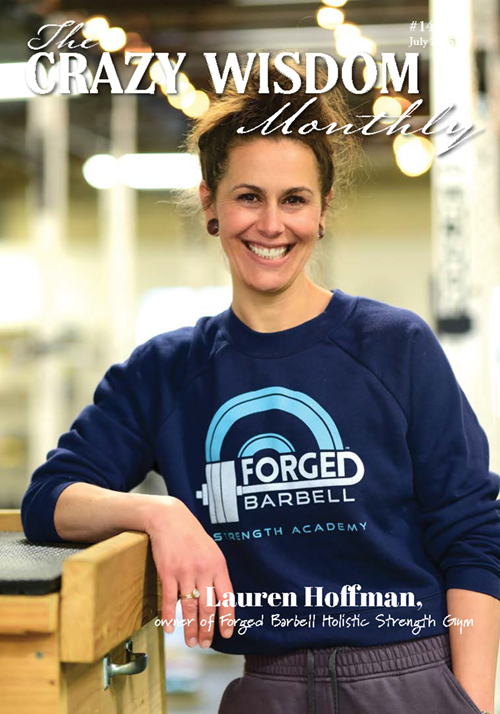Article by Kirsten Mowrey • Photography by Susan Ayer
““Write it. Shoot it. Publish it. Crochet it, sauté it, whatever — MAKE.” ”
We are in the midst of a quiet revolution, creeping from the secret places of our souls into the light of daily life: the desire to create, to build, to invent, to explore the world using our hands and our senses, and to do it in community. While sprouting everywhere, in Ann Arbor this “Maker Revolution” has the possibility to grow in bigger ways.
A local business expressing this cultural possibility is Maker Works. This member-based workshop focuses on satisfying a rising desire for craft and skill, and building a community of supporters.
Tucked away in the industrial area just north of the airport and just south of Zingerman’s Southside is a shop — and not just any shop. It is a makers’ shop where any member of the public can come, learn, and make their creative dreams come true.
“Makers” is the modern term for a blend of computer design, machining, D.I.Y., and craft. It’s “the garage workshop” with the addition of technology and programming. Some pieces are done by hand, some by machines running on computer programs. Some parts are controlled by circuits, which can be created from scratch or adapted from a template.
Walking into Maker Works, the main room is brightly lit, with a long desk, two clusters of computers for designing projects, and a long wall punctured by doors. Bulletin boards dot the wall: Business Strategies, Events and Groups, Business Cards. The mix on the final board is intriguing: architect, blacksmith, puppeteer, timber source, patent lawyer, quilter, artists of all types.
KC Dixon, the shop manager, stands by one of the computers overlooking a 13-year-old boy. Before he turns to greet me, I hear him comment on what’s on the screen. He tells me he will need more time to finish his tutorial. I wander off to explore, poking my head into the small, tool-crowded circuits room that adjoins the computer lab and continue around the corner where several sewing machines occupy tables. At one end is a heavy door, with a rack of safety glasses and a sign informing me I must wear them beyond this point.
Here, in the metal shop, I pass through large storage areas before entering the tool area. I feel a change in the air here. I sense not just the exhaust, but the lingering whiff of intense focus mixing with oil and metal. Through another door and on my right is the backlit “DO NOT LOOK DIRECTLY AT THE ARC WELDER” sign, warning me to be careful where my eyes stray. No one is working here currently, tall machines standing quiet, awaiting use. A bin labeled “scrap” tantalizes me with cutout sinuous shapes. I’ve reached the back of the shop, so I turn to my left, to the wood area.
Though windowless, this room is bright and airy, with high ceilings. Five members are scattered around the room at various machines and tables, measuring, aligning, or staring at plans. I catch the eye of the man running the ShopBot, a massive machine that dominates the far wall, with a long horizontal surface and a vertical cutter. We chat while the machine cuts circles in a piece of wood, moving precisely from one to another. Einor Jacobson tells me he’s doing a “fun project” with LED tubes — the machine is cutting the stand he will place the four-foot long bulbs in later. When I ask about his projects, he enthusiastically shows me photos of a tree he cut on the same machine last year for an event at his office. The tree has elongated scrolling limbs and an elegant 8-foot height, and I could easily imagine it as a play prop or in a kid’s bedroom. While we chat, the other members around us continue working. I recognize their gentle focus, having felt with my own projects how time becomes immaterial as you immerse yourself in work. The atmosphere is distinctly inventive yet the machines give the room an industrial feel. I exit the shop, place my glasses in a different rack, and return to KC.
When I ask him what a makerspace is, Dixon, a genial young man with tousled black hair in his thirties, enthusiastically compares it to a gym where you can go for a satisfying physical and mental workout. “I describe this makerspace as a gym with tools; instead of having like a treadmill, you can work on our actual mill. Instead of lifting weights, you can use the handsaw to make a bench rather than using a bench.”
“People have been doing this—,” he said gesturing to a wooden bench in the corner, “forever.” But, “This here,” he said, sweeping his arm across the expanse of Maker Works, “is a new idea.” He grins and continues in his husky voice, “There used to be co-op shops you could buy into, but a makerspace where anybody, I mean anybody, can come into [it], that’s new.”
Maker Works has daily, monthly, and yearly memberships offered at different rates depending on whether you are a student, a family, an individual, or a business. To use the tools, you pay a fee, and the use of most tools requires taking a checkout class regardless of how you join or how much experience you have.
“Safety is one of our biggest concerns,” said Dixon.
I would feel bad if someone hurt themselves. If it’s delicate or dangerous, it requires a checkout class. [The class is] focused on safety. We’re not gonna have you shoot a board across the room. Also, for the tools, if you use and abuse your tools, that’s one thing, but if you use and abuse our tools, you walk away. We want to have the tools accessible for everyone. We have skill development classes to make you an awesome woodworker, and we offer consulting on projects as well.
With that, in a gym with tools, I’m the personal trainer. I’m not going to lift the weights for you, you do it. But I will tell you, ‘O.K., now get the table saw set up,’ and guide you.
Not all tools are created equal, with some more popular than others. When I ask what is hot, Dixon replies immediately, “The laser cutter, for plastic. It’s accurate and you can engrave, it’s really approachable. The Shopbot C.N.C. router — you use the same drawing, out of wood.” C.N.C. stands for computerized numerical control, where you have a design that you have created with software, that you upload into the tools. C.N.C.s are able to make highly accurate cuts and waste less material. This is how Jacobson was able to chat with me while the cutting happened; he had loaded his program and was watching it execute.
I ask KC to explain a typical member’s day. “Coming in, heading to metal shop. Before they came in, they made a reservation on the tool, so we know they have it for two hours. They are going back to the metal shop working on stuff. They finish the job. On their way out, they decide to do something else, sign up for a tool or a class or work on their CAD files.”
“We have eight separate small businesses actively tied to this space: green energy tech, wood products, artists on commission, museum installations. They are making a living. This is their shop and they are here everyday. We have hobbyists. We have people coming in and doing jobs for others in the community. We have high school students coming in here and building robots. I love coming to work, it’s awesome.”
Dixon drew their business principles for me on the whiteboard: two triangles with different labels. The sides on the first triangle are labeled: people, profit, planet. “We want to hit all of them. We try to be green, we try to be mindful, we recycle.” The sides on the second triangle are labeled: maker$, 1099, and students. Maker$ refers to individuals whose primary income comes from making, while 1099 is the IRS tax code for independent contractors. The diagram is a flow chart, where the flow is from each group back to the other. Dixon explained the prosperity flow between Maker Works members: “The 1099s turn into the maker$, who can have that avenue to make some extra money. At the same time, maker$ can use 1099s when they need to, as employees or partners. Students then create a bridge to the 1099s.”
“If this interaction happened anywhere else in the world,” he explained, pointing to the “maker$/student” flow, “it would be like, ‘Hey kid, get out of my way.” Dixon’s eyes alight and he becomes more animated. “Here, I’ll see the kid on the laser and I’ll hear this crazy screaming, and I’ll tell the kid, ‘You need to slow it down. You need to hear the machine vibrating. You want to be listening for this.’ And that kind of passive skill development, it’s cool to see it happen.”
“It’s really funny to see it happening this direction,” he said, pointing to the flow from student to maker$. “So this guy is sitting out here,” gesturing to the adjacent computer room, where a student might be. “And this maker$ guy,” he said gesturing to the wood shop area, “he’s got tons of experience back there, fabricating manually, but he has zero on C.N.C., working on the computer drawing something.” But, “To the students, it’s intuitive, so they’ll say, ‘Hey man, if you hold here you can hit shift and select four of them at the same time,’ and this guy’s mind is blown! He is like, ‘You are the coolest kid!’ We actually have students getting jobs this way; students getting ideas, talking to our patent lawyer, prototyping, and getting patents.”
Maker works recently added a classroom with computers, pro memberships and an artist in residence program. For the future, KC said, they hope to add new tools such as a forge, treadle hammer, a jewelry space, and more skill development classes. “We want to be a good resource for the community.”





























































































































































































